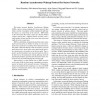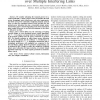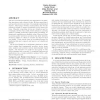901 search results - page 161 / 181 » Minimum power configuration in wireless sensor networks |
DIALM
2005
ACM
13 years 10 months ago
2005
ACM
Reducing interference is one of the main challenges in wireless communication, and particularly in ad hoc networks. The amount of interference experienced by a node v corresponds ...
BROADNETS
2004
IEEE
14 years 12 days ago
2004
IEEE
This paper presents Random Asynchronous Wakeup (RAW), a power saving technique for sensor networks that reduces energy consumption without significantly affecting the latency or c...
PERCOM
2008
ACM
14 years 8 months ago
2008
ACM
Low cost devices such as RFIDs, sensor network nodes, and smartcards are crucial for building the next generation pervasive and ubiquitous networks. The inherent power and footpri...
TWC
2008
13 years 8 months ago
2008
We consider allocating the transmit powers for a wireless multi-link (N-link) system, in order to maximize the total system throughput under interference and noise impairments, and...
MOBISYS
2007
ACM
14 years 8 months ago
2007
ACM
The area of medical monitoring and diagnostics is of particular importance and relevance today. Modern nanotechnology has reduced prices and size of increasingly sophisticated sen...



